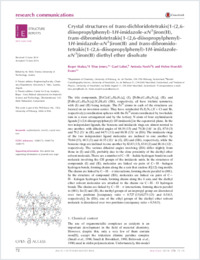Crystal structures of <i>trans</i>-dichloridotetrakis[1-(2,6-diisopropylphenyl)-1<i>H</i>-imidazole-Κ<i>N</i>³]iron(II), <i>trans</i>-dibromidotetrakis[1-(2,6-diisopropylphenyl)-1<i>H</i>-imidazole-Κ<i>N</i>³]iron(II) and <i>trans</i>-dibromidotetrakis[1-(2,6-diisopropylphenyl)-1<i>H</i>-imidazole-Κ<i>N</i>³]iron(II) diethyl ether disolvate
- Mafua, Roger Department of Chemistry, University of Fribourg, Switzerland
- Jenny, Titus A. Department of Chemistry, University of Fribourg, Switzerland
- Labat, Gael Benefri Crystallography Service, University of Neuchâtel, Switzerland
- Neels, Antonia Benefri Crystallography Service, University of Neuchâtel, Switzerland
- Stoeckli-Evans, Helen Institute of Physics, University of Neuchâtel, Switzerland
-
15.08.2014
Published in:
- Acta Crystallographica Section E Structure Reports Online. - 2014, vol. 70, no. 8, p. 72–76
English
The title compounds, [FeCl₂(C₁₅H₂₀N₂)₄], (I), [FeBr₂(C₁₅H₂₀N₂)₄], (II), and [FeBr₂(C₁₅H₂₀N₂)₄]·2C₄H₁₀O, (IIb), respectively, all have triclinic symmetry, with (I) and (II) being isotypic. The FeII atoms in each of the structures are located on an inversion center. They have octahedral FeX₂N₄ (X = Cl and Br, respectively) coordination spheres with the FeII atom coordinated by two halide ions in a trans arrangement and by the tertiary N atom of four arylimidazole ligands [1-(2,6-diisopropylphenyl)-1H-imidazole] in the equatorial plane. In the two independent ligands, the benzene and imidazole rings are almost normal to one another, with dihedral angles of 88.19 (15) and 79.26 (14)° in (I), 87.0 (3) and 79.2 (3)° in (II), and 84.71 (11) and 80.58 (13)° in (IIb). The imidazole rings of the two independent ligand molecules are inclined to one another by 70.04 (15), 69.3 (3) and 61.55 (12)° in (I), (II) and (IIb), respectively, while the benzene rings are inclined to one another by 82.83 (13), 83.0 (2) and 88.16 (12)°, respectively. The various dihedral angles involving (IIb) differ slightly from those in (I) and (II), probably due to the close proximity of the diethyl ether solvent molecule. There are a number of C-H***Missing image substitution***halide hydrogen bonds in each molecule involving the CH groups of the imidazole units. In the structures of compounds (I) and (II), molecules are linked via pairs of C-H...halogen hydrogen bonds, forming chains along the a axis that enclose R₂²(12) ring motifs. The chains are linked by C-H...π interactions, forming sheets parallel to (001). In the structure of compound (IIb), molecules are linked via pairs of C-H...halogen hydrogen bonds, forming chains along the b axis, and the diethyl ether solvent molecules are attached to the chains via C-H...O hydrogen bonds. The chains are linked by C-H...π interactions, forming sheets parallel to (001). In (I) and (II), the methyl groups of an isopropyl group are disordered over two positions [occupancy ratio = 0.727 (13):0.273 (13) and 0.5:0.5, respectively]. In (IIb), one of the ethyl groups of the diethyl ether solvent molecule is disordered over two positions (occupancy ratio = 0.5:0.5).
- Faculty
- Faculté des sciences et de médecine
- Department
- Département de Chimie
- Language
-
- English
- Classification
- Crystallography
- License
- License undefined
- Identifiers
-
- RERO DOC 211407
- DOI 10.1107/S1600536814014056
- Persistent URL
- https://folia.unifr.ch/unifr/documents/303648
Other files
Statistics
Document views: 99
File downloads:
- jen_cst.pdf: 97
- jen_cst_sm1.cif: 43
- jen_cst_sm2.cif: 39
- jen_cst_sm3.cif: 50
- jen_cst_sm4.cif: 47
- jen_cst_sm5.html: 46

